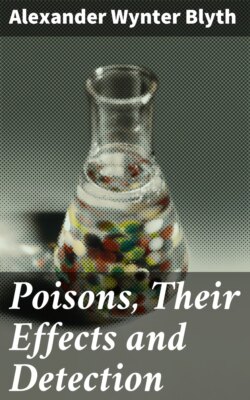Читать книгу Poisons, Their Effects and Detection - Alexander Wynter Blyth - Страница 54
На сайте Литреса книга снята с продажи.
ОглавлениеOscar Brasch[46] has within the last few years studied spectroscopy in relation to the alkaloids and organic poisons. Some of these, when mixed with Froehde’s reagent, or with sulphuric acid, or with sulphuric acid and potassic dichromate, or with nitric acid, give characteristic colours, and the resulting solutions, when examined by a spectroscope, for the most part show absorption bands; these bands may, occasionally, assist materially in the identification of a poison. By far the best apparatus is a micro-spectroscope of the Sorby and Browning type, to which is added an apparatus for measuring the position on a scale of the lines and bands. Seibert and Kraft of Wetzlar make an excellent instrument, in which a small bright triangle is projected on the spectrum; this can be moved by a screw, so that the apex may be brought exactly in the centre of any line or band, and its position read on an outside scale. The first thing to be done with such an instrument is to determine the position on the scale of the chief Fraunhofer lines or of the more characteristic lines of the alkalies and alkaline earths,[47] the wave lengths of which are accurately known. If, now, the scale divisions are set out as abscissæ, and the wave lengths in millionths of a millimetre are made the ordinates of a diagram, and an equable curve plotted out, as fully explained in the author’s work on “Foods,” it is easy to convert the numbers on the scale into wave lengths, and so make the readings applicable to any spectroscope. For the purpose of graphical illustration the curve method is convenient, and is adopted in the preceding diagrams, all taken from Oscar Brasch’s monograph. Where the curve is highest there the absorption band is thickest; where the curve is lowest there the band is weak. The fluid to be examined is simply placed in a watch-glass, the watch-glass resting on the microscope stand.
[46] Ueber Verwendbarkeit der Spectroscopie zur Unterscheidung der Farbenreactionen der Gifte im Interesse der forensischen Chemie, Dorpat, 1890.
[47] The alkalies and earths used for this purpose, with their wave lengths, are as follows: KCl, a line in the red λ 770, in the violet λ 404. Lithium chloride, red line, 670·5; sodium chloride, yellow, 589; strontium chloride, line in the blue, 461. It is also useful to measure the green line of thallium chloride = 535.
CURVES INDICATING THE POSITION OF ABSORPTION BANDS ON TREATING CERTAIN ALKALOIDS WITH REAGENTS.
NOTES TO CURVES INDICATING ABSORPTION BANDS.
1 Strychnine, treated with sulphuric acid and potassic dichromate (violet).
2 Brucine, treated with potassic nitrate and sulphuric acid (clear red).
3 Quebrachine, treated with vanadium sulphate (dark blue).
4 Quinine, Vogel’s reaction (red).
5 Caffein, Murexid reaction (violet-red).
6 Dephinoidin, Froehde’s reagent (cherry-red).
7 Veratrine, treated with sulphuric acid (straw-yellow).
8 Vera„rine, treate„ with sulp„uric acid (cherry-red).
9 Vera„rine, treate„ with sulp„uric acid (carmine-red).
10 Veratrine, Furfurol reaction (blue-violet).
11 Sabadillin, treated with sulphuric acid (red).
12 Veratroidine,eated„with sulph„ric acid (brown-red).
13 Jervine, Furfurol reaction (blue).
14 Sabadine, ur„urol rea„tion (blue).
15 Sabadine, treated with sulphuric acid (cherry-red).
16 Physostigmine,ed „ith sulph„ric acid (grass-green).
17 Morphine, treated with Froehde’s reagent and sugar (dark-green).
18 Narcotine, treated with a mixture of sulphuric acid and nitric acid (30 drops of sulphuric to 1 drop of nitric), (red).
19 Codeine, treated with Froehde’s reagent and sugar (dark violet).
20 Papaverine, treated with Froehde’s reagent (green-blue).
21 Sanguinarin, reat„d with Froeh„e’s reagent (violet-red).
22 Chelidonin,treate„d with sulphate of vanadium (dark green).
23 Solanin,in, treate„d with sulphuric acid and allowed to stand 4 hours (brown-red).
24 Digitalin,n, treate„d with Erdmann’s reagent (red).
25 Aniline, in, treate„d with sulphuric acid and potassic dichromate (blue).
The wave lengths corresponding to the numbers on the scale in the diagram are as follows:—
| W.L. | ||
|---|---|---|
| 0 | 732 | |
| 1 | 656 | |
| 2 | 589 | ·2 |
| 3 | 549 | ·8 |
| 4 | 510 | ·2 |
| 5 | 480 | ·0 |
| 6 | 458 | |
| 7 | 438 |
